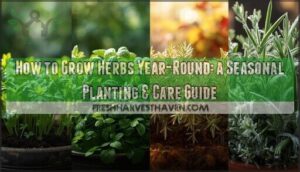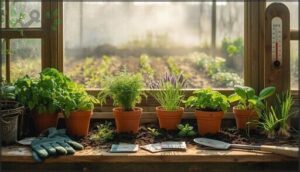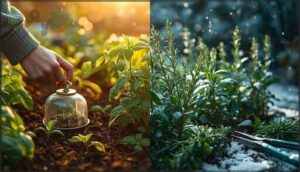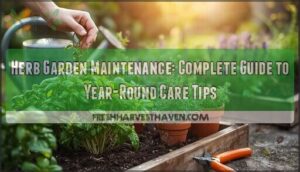This site is supported by our readers. We may earn a commission, at no cost to you, if you purchase through links.
Most gardeners treat herbs like fair-weather friends, planting basil in May and watching their garden go quiet by October. But herbs don’t actually follow a single growing season—they follow several. Cool-season varieties like cilantro bolt in summer heat, while Mediterranean natives like rosemary laugh at mild frost. Understanding these patterns means you can harvest fresh leaves in January just as easily as July.
The trick isn’t fighting your climate; it’s matching the right herbs to each season’s conditions. Once you learn which varieties thrive in spring’s cool soil, which ones need summer’s heat, and which actually prefer autumn’s shorter days, you’ll stop seeing gaps in your garden and start seeing opportunities.
Table Of Contents
Key Takeaways
- Herbs follow distinct seasonal growing patterns rather than a single season—cool-season varieties like cilantro thrive in spring and fall, while Mediterranean herbs like rosemary and thyme tolerate frost and prefer different conditions than heat-loving basil.
- Successful year-round herb gardening depends on matching soil preparation (pH 6.5-7.5, well-drained conditions, 6+ hours sunlight) with the right plant lifecycle—annuals require yearly replanting while perennials develop deeper roots and last multiple seasons with less maintenance.
- Strategic seasonal care dramatically impacts yields—regular pruning every 2-3 weeks increases biomass by 28%, removing flower buds extends harvest windows by four weeks, and proper mulching raises winter survival rates from 63% to 92%.
- Harvest timing determines flavor quality since essential oil content varies up to four times between seasons (thyme reaches 0.28% in summer versus 0.07% in winter), and proper preservation methods like freezing retain 90-95% of aromatic compounds for up to twelve months.
Preparing Soil and Selecting Herb Varieties
Before you plant a single herb, you need to get the foundation right. The soil your herbs grow in makes all the difference between thriving plants and disappointing yields.
Let’s walk through how to adjust your soil conditions and pick the right herbs for your garden’s rhythm.
Adjusting PH and Improving Drainage
Before planting, test your soil pH—most herbs thrive between 6.5 and 7.5. If soil acidity measures below 6.0, lime application can raise pH effectively.
For drainage, mixing in organic matter like compost or perlite benefits container soil mix by creating air pockets. Raised beds offer another solution when dealing with heavy clay, ensuring well-drained soil conditions that prevent root rot and encourage vigorous herb growth.
Many herbs also need at least six hours of direct sunlight.
Choosing Annual, Perennial, and Biennial Herbs
Once you’ve prepared the soil, consider herb lifecycles when selecting varieties. Annuals like basil and cilantro complete their cycle in one season, requiring replanting each year and increasing maintenance costs. Perennials such as rosemary and thyme develop deeper root systems, lasting multiple years with less upkeep. Biennials like parsley need two seasons to flower.
Climate influence and planting timing determine which types thrive in your garden. Understanding the difference between annual and perennial herbs is important for effective garden planning.
Planting Herbs by Season
Getting the timing right can make or break your herb garden. Different herbs thrive in different seasons, and understanding when to plant each variety sets you up for a harvest that doesn’t quit.
Let’s walk through what to plant and when, so you can keep fresh herbs coming all year long.
Best Herbs for Spring Planting
Spring is your cue to sow cool-season herbs like cilantro and dill one to two weeks before frost ends. Once soil warms to 60–70°F, transplant tender annuals such as basil outdoors. You can divide perennial herbs—chives, mint, oregano—as growth resumes. Direct sowing works well for parsley and calendula.
Regional timing matters: adjust planting dates by two to four weeks to dodge late frosts and increase seasonal yields.
Warm-Season Herbs for Summer Gardens
Once temperatures stay above 60°F, basil and summer savory thrive as warm-season annual herbs. Heat-tolerant varieties like rosemary, oregano, and thyme handle full sun with ease.
You’ll want well-drained soil amendments—add pine bark or gravel to boost drainage. Companion planting keeps pests at bay, while consistent watering strategies prevent wilt during heatwaves.
Mulch conserves moisture and improves airflow, greatly reducing summer disease risks.
Cool-Season Herbs for Autumn and Winter
As soil temperature drops in fall, frost-resistant herbs like cilantro, chervil, and parsley thrive. Cool season annual herbs handle early frosts, while perennials like thyme and oregano persist through winter with proper care.
For successful autumn herbs and winter herbs:
- Sow directly one month before last frost
- Mulch 2-4 inches deep for insulation
- Use season extension tunnels or cloches
- Apply targeted harvesting methods throughout cooler months
Winter herb care requires reduced watering and routine monitoring.
Adjusting Planting Dates by Region
Your Hardiness Zone determines when seasonal planting begins—gardeners in Zone 5b start growing herbs two months later than those in Zone 9a. Plant hardiness varies widely, so matching herb varieties to local conditions ensures year-round success with your favorite culinary and medicinal plants.
Check regional calendars for frost dates, then adjust for microclimates and altitude effects that shift timing by weeks.
Seasonal Care and Maintenance
Growing herbs successfully means adjusting your care routine as the seasons change. Your herbs need different levels of water, pruning, and protection depending on whether you’re dealing with summer heat or winter frost.
Here’s how to keep your herb garden thriving through every season of the year.
Watering and Humidity Needs by Season
Just like your herbs’ appetite changes with the seasons, so do their watering and humidity needs. Spring watering starts at 1–2 times weekly, ramping up in summer when many herbs require roughly 1 inch of water per week. As autumn reduction kicks in, dial back by 30–50%. Winter control means watering every 10–20 days.
Indoor humidity should hover between 40–60% for best seasonal herb care.
Pruning, Pinching, and Flower Removal
Regular pruning every two to three weeks during the growing season keeps your herbs bushy and productive, boosting biomass by up to 28%.
Pinching back mint, basil, and oregano when stems reach 10–15 cm doubles harvestable sprigs and increases leaf yield by 20–30%.
Removing flower buds extends your harvest window by four weeks and concentrates essential oils by 13%, keeping flavor at its peak.
Mulching and Winter Protection
When the first hard freeze arrives, mulch becomes your perennial herbs’ best defense against winter’s bite. Here’s how to protect your plants:
- Apply 2–3 inches of straw or bark mulch after ground temperatures drop below 0°C to boost herb survival rates from 63% to 92%.
- Choose organic mulch types that retain soil moisture 18% better than bare beds.
- Raise containers above ground level when mulched to prevent root rot.
- Layer straw with bark for 22% greater freeze protection during thaw cycles.
This timing and technique shields roots down to -20°C while unmulched herbs fail at -5°C.
Monitoring for Pests and Diseases
Pests and diseases can wipe out up to 40% of your herb harvest if you’re not watching closely. Check leaves weekly for insects, disease spots, or wilting—early detection cuts losses dramatically.
Integrated pest management (IPM) strategies, including biological controls and proper spacing for airflow, protect plant health while minimizing environmental impact.
Use monitoring tech like sticky traps to catch problems before they spread, making herb pest and disease control far more effective.
Growing Herbs in Containers Year-Round
Containers give you the freedom to grow herbs anywhere, from sunny windowsills to shaded patios, and they let you adjust placement as the seasons shift. Whether you’re working indoors or out, choosing the right container and drainage setup makes all the difference in keeping your herbs healthy year-round.
Here’s what you need to know to set up, place, and care for potted herbs through every season.
Selecting Containers and Drainage Solutions
Selecting herb containers means thinking through drainage and materials to keep roots happy. Container gardening succeeds when each element—from drainage hole size to potting mix—works together for well-drained soil.
Consider these essentials:
- Pot volume: Use 1–2 gallons for most herbs, 3+ gallons for rosemary.
- Drainage holes: Multiple 0.25–1 inch openings prevent waterlogging.
- Container material: Terracotta dries faster; plastic retains moisture.
- Potting mix: Blend perlite or grit for fast drainage.
- Saucer use: Empty standing water to avoid root rot; self-watering systems suit moisture-loving herbs only.
Indoor Vs Outdoor Container Gardening
Indoor versus outdoor container gardening shapes your watering schedule, pest management approach, and space utilization strategy. Indoor herbs need supplemental light for 12–16 hours daily but slash soil-borne pest incidence by over 80%.
Outdoor containers access full sunlight yet face higher water evaporation—up to 30%—and vulnerability to 15+ common pests.
Accessibility factors favor indoor year-round harvests, while outdoor setups suit herbs craving intense sun exposure.
Seasonal Placement and Care for Potted Herbs
Beyond choosing indoor or outdoor placement, you’ll shift your container’s location throughout the year to match each herb’s seasonal needs. Here’s what successful seasonal gardening demands:
- Spring through summer: Place containers where they’ll receive 6+ hours of direct sunlight daily—98% of potted species thrive with this exposure.
- Autumn positioning: Move heat-sensitive herbs like parsley to afternoon shade when temperatures climb past 90°F, protecting leaf quality.
- Winter frost protection: Bring tender herbs indoors before the first freeze; severe frost below 24°F damages 94% of potted varieties irreversibly.
Your watering schedule intensifies during peak summer, when evaporation rates spike 38% in southern climates. Container herbs dry 25% faster than ground-planted ones, so check soil moisture frequently. Winter herb care flips the script—reduce watering but maintain indoor humidity above 45% to prevent tip burn in 81% of species.
Smart fertilization strategies support vigorous growth: feed monthly during active spring and summer months, then taper off in fall. Over-fertilizing during dormancy increases root rot susceptibility by 15%.
For effective stressor management and frost protection, insulate containers during winter—this cuts root zone temperature swings by 51%. Mulch your overwintering pots and shelter them from wind to boost survival rates up to 89% in parsley, sage, chives, and thyme.
Harvesting and Preserving Herbs Each Season
Getting the harvest timing right can mean the difference between bland leaves and bold flavor. Once you’ve grown healthy herbs through each season, you’ll want to know exactly when to cut them and how to preserve what you’ve worked for.
Let’s walk through the best practices for harvesting and keeping your herbs fresh, no matter what time of year it’s.
Timing Harvests for Peak Flavor and Aroma
Harvesting herbs at the right moment means capturing peak oil content before it declines. Flavor compound shifts dramatically across seasons—thyme’s essential oils reach 0.28% in summer versus just 0.07% in winter.
Harvest herbs at peak oil content—thyme’s essential oils are four times stronger in summer than winter
Regional harvest windows vary by up to three weeks, impacting both herb oil concentration and nutritional value. Morning harvests preserve aroma best, while timing before flowering maximizes flavor compound retention and herb flavor enhancement potential.
Techniques for Cutting and Regrowing Herbs
With proper harvesting techniques, you’ll master cut-and-come-again yields that keep giving. Cut stems at 45-degree angles above leaf nodes to trigger 77% bushing success in basil and oregano within two weeks. Rooting hormones boost propagation by 30%, while humidity control at 80–90% increases survival by 35%. Follow these strategies:
- Take semi-ripe cuttings in late summer for 65% success
- Maintain 20–24°C for best root initiation
- Harvest every 30 days for 53 tillers per plant
- Use well-draining media to reduce fungal losses by 28%
Regular herb foliage maintenance increases annual yields 18–22% over single harvests.
Drying, Freezing, and Storing Seasonal Harvests
After harvesting herbs, you’ll preserve peak flavors through strategic preservation. Direct sun drying cuts basil moisture from 87.7% to 10% in six hours, while freezing retains 90–95% of aromatic compounds for up to twelve months at −18°C.
Store dried herbs in airtight containers away from light to maintain potency for a full year, keeping water activity below 0.65 to prevent mold.
Frequently Asked Questions (FAQs)
Can herbs tolerate frost or extreme cold?
Think of frost as a test of character—some herbs stand firm, while others fold. Winter hardiness varies widely: hardy perennials like sage and thyme tolerate extreme cold, but tender annuals need seasonal protection from temperature damage.
How do herbs respond to drought conditions?
Drought triggers significant biomass reduction in herbs, but they adapt through deeper roots, increased essential oils, and better water efficiency.
Genotype variability means some species tolerate dry conditions better than others, affecting your watering schedule.
What are companion plants that benefit herbs?
Forget growing herbs in lonely isolation—that’s so last century. Companion planting for herbs brings pest reduction, yield increase, and soil health improvements.
Plant basil with tomatoes, rosemary near beans, or chives alongside carrots to attract pollinators while achieving natural pest control.
When should perennial herbs be divided?
You should divide perennial herbs in spring or fall when root growth is active.
Watch for plant decline—reduced flowering, smaller leaves, or center dieback—signaling it’s time to divide for improved root health and propagation success.
How does altitude affect herb growing success?
Altitude, soil pH, and growing conditions shift dramatically as elevation increases. You’ll notice herb leaf size shrinks, planting date shifts occur by 3–4 weeks, and perennial herb dominance rises where sunlight, temperature tolerance, and plant hardiness matter most.
Conclusion
The moment you stop treating your garden like it has an off-season, something shifts. You’ll notice cilantro thriving in November, rosemary pushing new growth through February’s chill, basil finally behaving itself in controlled indoor light.
Growing herbs in different seasons isn’t about forcing plants into unnatural rhythms—it’s about recognizing that your garden never actually stops. It just changes partners. Match the right herb to the right moment, and you’ll never run out of fresh leaves again.
- https://www.lsuagcenter.com/profiles/truffin/articles/page1490883319765
- https://mgnv.org/plants/veg-herbs/seasonal-guide-growing-herbs/
- https://svaec.ifas.ufl.edu/media/svaecifasufledu/docs/pdf/svreports/crops/leafygreens/Fresh-cut-herbs-in-Vertical-hydroponic-Systems.pdf
- https://pmc.ncbi.nlm.nih.gov/articles/PMC11369235/
- https://medicgrow.com/blogs/news/grow-room-setup-optimal-temp-humidity-for-plants











